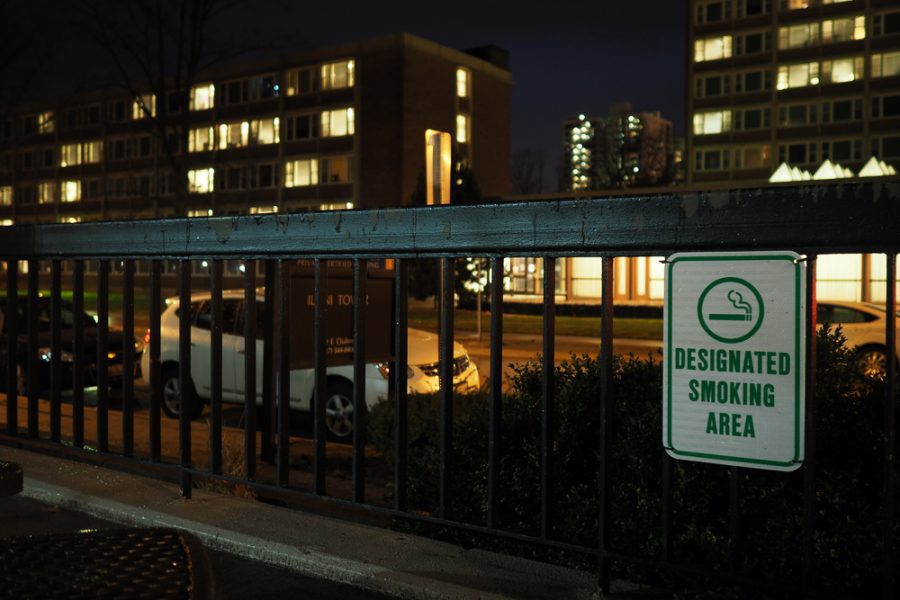University act doesn’t ash out smoking
The Illini Tower has a designated smoking area outside the main building.
Mar 1, 2017
The Chapel of St. John the Divine Episcopal Church is a favorite place for smokers to congregate — the outside the church, specifically, is private property and exempt from the University’s Smoke-Free Campus Act.
Smoking is a health concern across America and, according to the Centers for Disease Control, is responsible for more than 480,000 deaths per year. On campus, students may not realize that smoking is still a problem among students even though the Smoke-Free Campus Act prohibits it.
“As of January 1, 2014, smoking is prohibited on all Campus Property at the University of Illinois at Urbana–Champaign, both indoors and outdoors, and in university-owned vehicles and in privately-owned vehicles parked on Campus Property,” according to the Campus Administrative Manual.
The purpose of the act is to provide a healthy environment for students, faculty and staff across campus. The act strives to limit the negative effects of secondhand smoke and improve fire safety.
Even though the act has been in place for three years, UIPD Lt. John Brown said the police department does not focus on issuing citations for smoking on campus. In fact, since July 1, the UIPD has only given out about 145 tickets for smoking on campus.
Get The Daily Illini in your inbox!
“Occasionally, we do get a call about someone smoking on our property some place,” Brown said. “But by the time we get there, generally the person is gone, and we’re not going to spend a lot of time trying to locate somebody that’s committed a non-criminal offense when we have more serious crimes to worry about.”
Prior to the Smoke-Free Campus act, students, faculty and community members could smoke on the Main Quad, in front of University buildings and other places around campus.
“When people needed to get into classrooms or administrative buildings or anywhere, they oftentimes had to walk through a crowd of people who were smoking by the doorways,” said Michele Guerra, University Wellness Center Director.
A group of students who were concerned about the public health danger of secondhand smoke initiated the act, Guerra said.
It took 18 to 24 months of preparation before the University implemented the policy, and before the policy could move forward, the initiators had to gain student support. Eventually, they got the policy placed on the referendum.
Guerra said the policy was highly supported and 70 percent of students who voted in the Campus Student Election voted in favor of the Smoke-Free Campus Act.
The University announced the policy in 2012 but didn’t go into action until Jan. 1, 2014.
There are repercussions for failing to comply with the act, though the penalties for being caught smoking on University property have changed over time. Initially, the University Wellness Center took an educational approach.
The center had students who were smoke-free ambassadors. When ambassadors saw people smoking, they would educate them on the policy. The ambassadors worked to help students understand the risks of secondhand smoke, not to prevent them from smoking in the future. Guerra said the ambassadors wanted people around campus to understand the health concerns surrounding public smoking.
After almost two years of educational reinforcement, the center shifted to a more disciplinary approach.
For the first offense, a written warning is issued. The second offense is a $25 fine, which offenders can waive by completing an educational program within 72 hours of the citation. The third offense is $50, and the fourth offense is $100.
Brown said the authority to issue citations falls under housing security guards.
UIPD does get calls reporting that a person is smoking, but often the offense takes place on Champaign or Urbana property and not University property.
It is not exactly clear where campus property ends and where Campustown begins in respect to the ban. The University owns some roads and sidewalks, while Champaign or Urbana own others that run near campus.
Brown said students and staff who are smokers learn quickly where they can smoke without violating the policy.
Bars and restaurants do not fall under the act as they are not University-owned property. Depending on their location, other buildings fall under Champaign or Urbana ordinance. Champaign repealed its smoking ban in May 2007, only months after it went into effect in January 2007. The ban prohibited smoking in public places including city and campus bars and was repealed due in part to pushback from Champaign bar owners.
The local repeal was also influenced by the statewide smoking ban, which began on Jan. 1, 2008.
“The Smoke-Free Illinois Act protects the public from the harmful effects of exposure to tobacco smoke by prohibiting smoking in public places and places of employment and within 15 feet of any entrance, exit, windows that open, or ventilation intake of a public place or place of employment,” according to the Illinois Department of Public Health.
However, the law exempts beer gardens, such as the outdoor sections of The Red Lion or KAM’S, because these areas typically do not have “permanent or temporary walls,” and they are not enclosed.
While smoking still persists around campus, Guerra said the situation has improved since the act was put into place.
“I see so much less of that, and I think that overall the campus is a much healthier place with this policy,” Guerra said.






